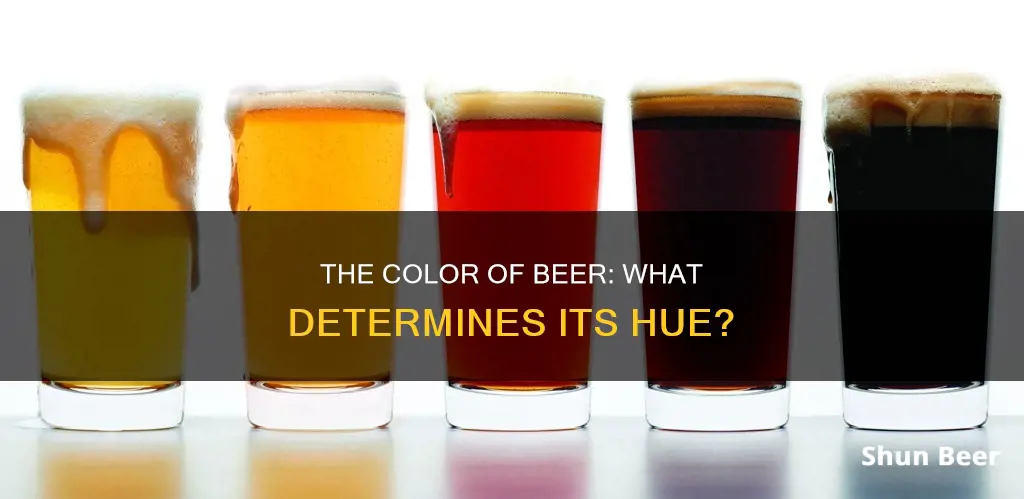
The colour of beer is determined by a variety of factors, including the ingredients used, the roasting process, and the duration of mashing and filtration. The type of grain used is one of the most critical factors, as grains are coloured by melanin, a rust-red pigment. Lighter beers tend to be softer and crisper, while darker beers are more intense and bitter. The roasting process, also known as the Maillard Reaction, involves heating the germinated barley, with the temperature affecting the final colour of the beer. Additionally, the pH level during the mashing process influences the colour, with higher pH resulting in a darker beer. The duration of mashing and filtration also play a role, with longer mashing times leading to darker beers, and filtration removing coloured molecules, resulting in lighter beers. While colour can provide some cues about the taste and strength of a beer, it is not always a reliable indicator, and the best way to determine a beer's characteristics is to taste it.
| Characteristics | Values |
|---|---|
| Most significant source of beer colour | Pigments in the grain |
| Colour of grain | Coloured by melanin, a rust-red pigment |
| Colour of unfiltered beer | Hazier and brighter |
| Colour of filtered beer | Lighter |
| Colour of beer and taste | No link |
| Colour of beer and alcohol content | No link |
| Beer colour measurement | Standard Reference Method (SRM) scale |
| Colour of light beers | Pale straw |
| Colour of dark beers | Black |
| Colour of medium beers | Gold, amber, brown |
What You'll Learn

The role of grain in colouring beer
Maillard reactions occur when amino acids are linked to sugars, usually through the introduction of heat. This process is responsible for the browning of grains and is associated with a darkening of the beer's colour. The longer the grains are subjected to heat, the darker they will become.
Caramelization, on the other hand, is the process of heating sugar until it breaks down. In order to caramelize the sugars in grains, the starch in the grain must first be converted into sugar through heating. The longer the caramelization process, the darker the beer will be.
The type of grain used and the ratio in which they are used also play a crucial role in determining the colour of the beer. Dark malts will impart a darker colour, while very pale malts can also turn beer darker as the colour builds. Even small amounts of chocolate or roasted malts, which are non-caramelised malts kilned at high temperatures, can add deeper colours to the beer.
Therefore, the colour of beer is largely determined by the grain used and the chemical processes applied to it. Brewers can manipulate these factors to create beers with a wide range of colours, from light straw to black.
Beer Styles: Ale, Lager, and Their Differences Explained
You may want to see also

The Maillard reaction
Maillard browning reactions also take place in the kettle during wort boiling and can develop deeper colours in worts. They also occur during the mash boiling phases of decoction mashes, and proponents of decoction mashing claim that superior depth of malt flavour can result. The Maillard reaction can be influenced by factors such as the length of boiling time, with longer boiling times resulting in more browning.
Exploring the Vast World of Beer: A Guide to Brands
You may want to see also

Caramelisation
The flavour compounds produced during caramelisation can include burnt sugar, butter, dark fruit, and toffee notes. The longer the caramelisation process, the more intense these flavours will become. Additionally, the caramelisation process can also produce non-fermentable sugars, which will add flavour but not contribute to the potential alcohol content of the beer.
Caramelised malts, also known as crystal malts, are commonly used in beer brewing to achieve specific colour and flavour profiles. These malts are produced by intense heating and stewing of the grains, resulting in a range of colours from light carapils to dark crystal malts. The use of these malts allows brewers to create beers with a variety of flavours, such as toffee, caramel, and sweet notes, without the burnt harshness associated with heavily kilned malts.
Oklahoma Beer: Unique Taste or Marketing Ploy?
You may want to see also

Timing and ageing
Time is an important factor in the coloration of beer. In brewing circles, there is a saying that "time is color". This means that as beer ages, there will be perceptible changes in coloration. Aging also creates new flavour perceptions, the most notable of which is that beers become less bitter as the isomerized alpha acids that make the beer bitter break down over time, and the malts are emphasised.
As a beer ages, particles in suspension within the beer – such as yeast and polyphenols – begin to fall to the bottom of the vessel. The remaining beer will reflect less light, making it appear darker. In this way, age by itself will darken beer over time. The aging process can be accelerated by oxidation.
Oxygen is a key component in the degradation of organic products and can have a pronounced effect on beer colour. The oxidative process that turns bananas brown has the same basic effect on beer. Just like with stale fruit or bread, you will notice flavour differences. Flavours will first become muted, and if oxidation is more severe, off-flavours like cardboard or wet paper can develop. Not all aged, oxidative flavours are bad, though. The sherry or vinous flavours that result from oxidised melanoidins can be very pleasant in amber or dark beers.
Beers can be stored for a few months, or even years, in the right conditions. The "right conditions" in which to store and/or age beer are dark and moderately cold. Beers like to age in dank basements or dark garages, anywhere that's generally cool (55°F is a good rule of thumb) and free of sunlight. UV rays in sunlight can "skunk" your beer, or impart off-flavours.
Beer Size Matters: How Larger Brews Differ
You may want to see also

Oxidation
Oxygen exposure degrades lively alcohols and aromatics in beer, turning them into bland versions of their former selves. The oxidative process can cause off-flavours, such as cardboard or wet paper, to develop. The oxidation of melanoidins, which are created during the malting process and the kettle boil, can give the beer a slight taste of sherry. In cold brew, oxygen can turn alcohol into almond-tasting aldehydes.
The oxidation of polyphenols, also referred to as tannins, derived from malt husks and hops, can contribute to red-brown colours in beer. This effect can be observed by boiling hops in water for an hour or so. The reduction of polyphenol levels and wort oxidation can help reduce colour formation from this source, which is important for brewers aiming for very light-coloured beers.
While oxidation is usually undesirable, there are a few beer styles that can improve with some long-term oxygen exposure, such as barley wines, old ales, and imperial stouts. The melanoidins in dark beers can oxidise into sherry-like flavours, complementing the dark malts. However, this is not a reason to intentionally introduce oxygen into the beer, as it is almost always detrimental.
Tequila vs Beer: A Different Drunk?
You may want to see also
Frequently asked questions
The duration and temperature of kilning influence the colour of the final product. The longer the grains are kilned, the darker the beer will be.
The Maillard reaction is a chemical process that occurs when you link amino acids to sugars, usually prompted by the introduction of heat. This process is associated with the darkening of the beer's colour.
The Maillard reaction is associated with toasty flavours, while caramelization produces flavours like burnt sugar, butter, dark fruit, and toffee.







